Optimizing Cotton Irrigation Strategies in Arid Regions Under Water–Salt–Nitrogen Interactions and Projected Climate Impacts
Abstract
1. Introduction
2. Materials and Methods
2.1. Field Trial
2.2. Data Sources
2.2.1. Site Data
2.2.2. GCM Data
2.3. RZWQM2 Application
2.4. Test Items and Methods
2.4.1. Soil and Plant Parameter Measurements
2.4.2. Effective Accumulated Temperature and Compensation Coefficient
2.4.3. Cotton Growth Index
2.4.4. Data Processing and Analysis Methods
3. Results
3.1. Cotton Growth Response to Different Water, Salt, and Nitrogen Treatments
3.1.1. Physiological Indexes and Yield of Cotton
3.1.2. Characteristics of Aboveground Dry Matter Accumulation in Cotton
3.2. Adaptability Test of the RZWQM2 Model
3.2.1. Simulation of Soil Water Using the RZWQM2 Model
3.2.2. Simulation of Soil Nitrate Nitrogen Using the RZWQM2 Model
3.2.3. Simulation of Aboveground Biomass and Yield of Cotton Using the RZWQM2 Model
3.3. Selection of Irrigation Schemes Under Different Water, Salt, and Nitrogen Regulations for Cotton
3.4. Response of Cotton Growth to Future Climate Changes
3.4.1. Climate Characteristics of the Study Area Under Future Climate Scenarios
3.4.2. Prediction of Cotton Growth Cycle Under Future Climate Change
3.4.3. Prediction of Yield and Aboveground Biomass Under Future Climate Change
3.4.4. ETpot and WUE Predictions Under Future Climate Change
4. Discussion
4.1. Effects of Different Water, Salt, and Nitrogen Conditions on Cotton Growth
4.2. Application of the RZWQM2 Model in Cotton Growth Simulation
4.3. Effect of Elevated eCO₂ Levels on Cotton
4.4. Uncertainty Analysis of Future Climate Scenarios
5. Conclusions
Supplementary Materials
Author Contributions
Funding
Data Availability Statement
Conflicts of Interest
References
- Chen, T.; Yang, X.; Zuo, Z.; Xu, H.; Yang, X.; Zheng, X.; He, S.; Wu, X.; Lin, X.; Li, Y.; et al. Shallow wet irrigation reduces nitrogen leaching loss rate in paddy fields by microbial regulation and lowers rate of downward migration of leaching water: A 15N-tracer study. Front. Plant Sci. 2024, 15, 1340336. [Google Scholar] [CrossRef] [PubMed]
- Zhang, F.; Qu, Z.; Zhao, Q.; Xi, Z.; Liu, Z. Mechanisms of N2O Emission in Drip-Irrigated Saline Soils: Unraveling the Role of Soil Moisture Variation in Nitrification and Denitrification. Agronomy 2025, 15, 10. [Google Scholar] [CrossRef]
- Duc, K.N.; Ancev, T.; Randall, A. Evidence of climatic change in Vietnam: Some implications for agricultural production. J. Environ. Manag. 2018, 231, 524–545. [Google Scholar]
- Kim, K.-H.; Lee, B.-M. Effects of Climate Change and Drought Tolerance on Maize Growth. Plants 2023, 12, 3548. [Google Scholar] [CrossRef] [PubMed]
- Wang, H.L.; Gan, Y.T.; Wang, R.Y.; Niu, J.Y.; Zhao, H.; Yang, Q.G.; Li, G.C. Phenological trends in winter wheat and spring cotton in response to climate changes in northwest China. Agric. For. Meteorol. 2008, 148, 1242–1251. [Google Scholar] [CrossRef]
- Abbas, G.; Ahmad, S.; Ahmad, A.; Nasim, W.; Fatima, Z.; Hussain, S.; Rehman, M.H.u.; Khan, M.A.; Hasanuzzaman, M.; Fahad, S.; et al. Quantification the impacts of climate change and crop management on phenology of maize-based cropping system in Punjab, Pakistan. Agric. For. Meteorol. 2017, 247, 42–55. [Google Scholar] [CrossRef]
- Dermody, O.; Weltzin, J.F.; Engel, E.C.; Allen, P.; Norby, R.J. How do elevated [CO2], warming, and reduced precipitation interact to affect soil moisture and LAI in an old field ecosystem? Plant Soil 2007, 301, 255–266. [Google Scholar] [CrossRef]
- Tavakkoli, E.; Rengasamy, P.; McDonald, G.K. High concentrations of Na+ and Cl− ions in soil solution have simultaneous detrimental effects on growth of faba bean under salinity stress. J. Exp. Bot. 2010, 61, 4449–4459. [Google Scholar] [CrossRef]
- Broughton, K.; Nunn, C.; Bange, M. The here and now of climate change: Climatic trends throughout Australian cotton regions and implications for the growing season. Field Crops Res. 2024, 315, 109491. [Google Scholar] [CrossRef]
- Ahmad, S.; Ahmad, I.; Ahmad, B.; Ahmad, A.; Wajid, A.; Khaliq, T.; Abbas, G.; Wilkerson, C.J.; Hoogenboom, G. Regional integrated assessment of climate change impact on cotton production in a semi-arid environment. Clim. Res. 2023, 89, 113–132. [Google Scholar] [CrossRef]
- Wang, Z.; Qi, Z.; Xue, L.; Bukovsky, M. RZWQM2 simulated management practices to mitigate climate change impacts on nitrogen losses and corn production. Environ. Model. Softw. 2016, 84, 99–111. [Google Scholar] [CrossRef]
- Chen, X.; Qi, Z.; Gui, D.; Gu, Z.; Ma, L.; Zeng, F.; Li, L. Simulating impacts of climate change on cotton yield and water requirement using RZWQM2. Agric. Water Manag. 2019, 222, 231–241. [Google Scholar] [CrossRef]
- Cheng, H.; Shu, K.; Qi, Z.; Ma, L.; Jin, V.L.; Li, Y.; Schmer, M.R.; Wienhold, B.J.; Feng, S. Effects of residue removal and tillage on greenhouse gas emissions in continuous corn systems as simulated with RZWQM2. J. Environ. Manag. 2021, 285, 112097. [Google Scholar] [CrossRef] [PubMed]
- Amouzou, K.A.; Naab, J.B.; Lamers, J.P.A.; Borgemeister, C.; Becker, M.; Vlek, P.L.G. CROPGRO-Cotton model for determining climate change impacts on yield, water- and N- use efficiencies of cotton in the Dry Savanna of West Africa. Agric. Syst. 2018, 165, 85–96. [Google Scholar] [CrossRef]
- Xu, Y. Effects of Film Amount on Soil Physical Properties and Crop Growth in Cotton Field. Master’s Thesis, Shihezi University, Shihezi, China, 2022. [Google Scholar]
- Wu, L.; Zhang, F.; Zhou, H.; Suo, Y.; Xue, F.; Zhou, J.; Liang, F. Effect of drip irrigation and fertilizer application on water use efficiency and cotton yield in North of Xinjiang. Trans. Chin. Soc. Agric. Eng. 2014, 30, 137–146. [Google Scholar]
- Liu, L. Constitute and Distributing Character of Salinity in Soil in Xinjiang. Arid Environ. Monit. 2009, 23, 227–229. [Google Scholar]
- Wu, F.; Qiu, Y.; Huang, W.; Guo, S.; Han, Y.; Wang, G.; Li, X.; Lei, Y.; Yang, B.; Xiong, S.; et al. Water and heat resource utilization of cotton under different cropping patterns and their effects on crop biomass and yield formation. Agric. For. Meteorol. 2022, 323, 109091. [Google Scholar] [CrossRef]
- Hinrichsen, K. The Ångström formula with coefficients having a physical meaning. Sol. Energy 1994, 52, 491–495. [Google Scholar] [CrossRef]
- Xiang, Y.; Cheng, R.; Wang, M.; Ding, Y. Response of Matching Degree between Precipitation and Maize Water Requirement to Climate Change in China. Agronomy 2024, 14, 181. [Google Scholar] [CrossRef]
- Nolan, B.T.; Puckett, L.J.; Ma, L.; Green, C.T.; Bayless, E.R.; Malone, R.W. Predicting Unsaturated Zone Nitrogen Mass Balances in Agricultural Settings of the United States. J. Environ. Qual. 2010, 39, 1051–1065. [Google Scholar] [CrossRef]
- Jamieson, P.D.; Porter, J.R.; Wilson, D.R. A test of computer simulation model ARC-WHEAT1 on wheat crops grown in New Zealand. Field Crop Res. Field Crops Res. 1991, 27, 337–350. [Google Scholar] [CrossRef]
- Ding, D.; Li, T.; Wu, L.; Zhang, X.; Zhao, Y.; Feng, H.; Zhang, C.; Wendroth, O. Energy Compensation for Crop Growth under Plastic Mulching: Theories, Models, and Limitations. Agronomy 2024, 14, 1005. [Google Scholar] [CrossRef]
- Hussain, S.; Teshome, F.T.; Tulu, B.B.; Awoke, G.W.; Hailegnaw, N.S.; Bayabil, H.K. Leaf area index (LAI) prediction using machine learning and UAV based vegetation indices. Eur. J. Agron. 2025, 168, 127557. [Google Scholar] [CrossRef]
- Zhang, D.; Liang, H.; He, X.; Shi, Y. Estimation of runoff and hydrological drought in the Jinsha River Basin based on CMIP6. Water Resour. Prot. 2023, 39, 53–62. [Google Scholar]
- Tong, Y.; Gao, X.; Han, Z.; Xu, Y.; Xu, Y.; Giorgi, F. Bias correction of temperature and precipitation over China for RCM simulations using the QM and QDM methods. Clim. Dyn. 2020, 57, 1425–1443. [Google Scholar] [CrossRef]
- He, C.; Luo, C.; Chen, F.; Long, A.; Tang, H. CMIP6 multi-model prediction of future climate change in the Hotan River Basin. Earth Sci. Front. 2023, 30, 515–528. [Google Scholar]
- Wang, H.; Yin, Z.; Zhang, L.; Zhao, F.; Huang, W.; Wang, X.; Gao, Y. Irrigation modulates the effect of increasing temperatures under climate change on cotton production of drip irrigation under plastic film mulching in southern Xinjiang. Front. Plant Sci. 2022, 13, 1069190. [Google Scholar] [CrossRef]
- An, M.; Zhu, Y.; Chang, D.; Wang, X.; Wang, K. Metabolic and Photosynthesis Analysis of Compound-Material-Mediated Saline and Alkaline Stress Tolerance in Cotton Leaves. Plants 2025, 14, 394. [Google Scholar] [CrossRef]
- Shangguan, X.; Wang, X.; Yuan, M.; Gao, M.; Liu, Z.; Li, M.; Zong, R.; Sun, C.; Zhang, M.; Li, Q. Effects of long-term biodegradable film mulching on yield and water productivity of maize in North China Plain. Agric. Water Manag. 2024, 304, 109094. [Google Scholar] [CrossRef]
- Chen, H.; Jeanne Huang, J.; Li, H.; Wei, Y.; Zhu, X. Revealing the response of urban heat island effect to water body evaporation from main urban and suburb areas. J. Hydrol. 2023, 623, 129687. [Google Scholar] [CrossRef]
- Huang, X.; Xu, B.; Tan, S.; Huang, Y.; Xi, J.; Qin, X.; Chen, T.; Chen, H.; Yang, X.; Yi, K. Transcriptome Sequencing of Agave angustifolia Reveals Conservation and Diversification in the Expression of Cinnamyl Alcohol Dehydrogenase Genes in Agave Species. Agriculture 2022, 12, 1003. [Google Scholar] [CrossRef]
- Jiang, X.; Liu, C.; Hu, Y.; Shao, K.; Tang, X.; Gao, G.; Qin, B. Salinity-Linked Denitrification Potential in Endorheic Lake Bosten (China) and Its Sensitivity to Climate Change. Front. Microbiol. 2022, 13, 922546. [Google Scholar] [CrossRef] [PubMed]
- Wang, Z.; Wang, C. Interactive effects of elevated temperature and drought on plant carbon metabolism: A meta-analysis. Glob. Change Biol. 2023, 29, 2824–2835. [Google Scholar] [CrossRef]
- Li, Y.; Feng, Q.; Li, D.; Li, M.; Ning, H.; Han, Q.; Hamani, A.K.M.; Gao, Y.; Sun, J. Water-Salt Thresholds of Cotton (Gossypium hirsutum L.) under Film Drip Irrigation in Arid Saline-Alkali Area. Agriculture 2022, 12, 1769. [Google Scholar] [CrossRef]
- Parkash, V.; Snider, J.L.; Virk, G.; Dhillon, K.K.; Lee, J.M. Diffusional and Biochemical Limitations to Photosynthesis Under Water Deficit for Field-Grown Cotton. Physiol. Plant. 2024, 176, e14281. [Google Scholar] [CrossRef]
- Lin, M.; Wang, L.; Lv, G.; Gao, C.; Zhao, Y.; Li, X.; He, L.; Sun, W. Deficit Irrigation Effects on Cotton Growth Cycle and Preliminary Optimization of Irrigation Strategies in Arid Environment. Plants 2024, 13, 1403. [Google Scholar] [CrossRef]
- Kumar, R.; Pareek, N.K.; Kumar, U.; Javed, T.; Al-Huqail, A.A.; Rathore, V.S.; Nangia, V.; Choudhary, A.; Nanda, G.; Ali, H.M.; et al. Coupling Effects of Nitrogen and Irrigation Levels on Growth Attributes, Nitrogen Use Efficiency, and Economics of Cotton. Front. Plant Sci. 2022, 13, 890181. [Google Scholar] [CrossRef]
- He, P.; Yu, S.e.; Zhang, F.; Ma, T.; Ding, J.; Chen, K.; Chen, X.; Dai, Y. Effects of Soil Water Regulation on the Cotton Yield, Fiber Quality and Soil Salt Accumulation under Mulched Drip Irrigation in Southern Xinjiang, China. Agronomy 2022, 12, 1246. [Google Scholar] [CrossRef]
- Bo, L.; Zhao, Y.; Mao, X.; Chen, S. Response and Simulation of Farmland Water Salt Transport and Growth of Crops to Deficit Drip Irrigation. Trans. Chin. Soc. Agric. Mach. 2021, 52, 248–255. [Google Scholar]
- Qadir, M.; Shams, M. Some Agronomic and Physiological Aspects of Salt Tolerance in Cotton (Gossypium hirsutum L.). J. Agron. Crop Sci. 1997, 179, 101–106. [Google Scholar] [CrossRef]
- Wang, T.; Wang, Z.; Zhang, J.; Ma, K. An optimum combination of irrigation amount, irrigation water salinity and nitrogen application rate can improve cotton (for fiber) nitrogen uptake and final yield. Ind. Crops Prod. 2022, 187, 115386. [Google Scholar] [CrossRef]
- Ma, Y.Y.; Wei, Z.H.; Liu, J. Growth and physiological responses of cotton plants to salt stress. J. Agron. Crop Sci. 2021, 207, 565–576. [Google Scholar] [CrossRef]
- Hussain, K.; Ilyas, A.; Ali, S.; Bibi, I.; Shakil, Q.; Farid, M.; Saqib, Z.; Habib, A.; Hakki, E. Impacts of Nitrogen Fertilizer Application and Mulching on the Morpho-Physiological and Yield-Related Traits in Cotton. Agriculture 2022, 13, 12. [Google Scholar] [CrossRef]
- Tian, Y.; Tian, L.; Wang, F.; Shi, X.; Shi, F.; Hao, X.; Li, N.; Chenu, K.; Luo, H.; Yang, G. Optimizing nitrogen application improves its efficiency by higher allocation in bolls of cotton under drip fertigation. Field Crops Res. 2023, 298, 108968. [Google Scholar] [CrossRef]
- Saseendran, S.A.; Ma, L.; Malone, R.; Heilman, P.; Ahuja, L.R.; Kanwar, R.S.; Karlen, D.L.; Hoogenboom, G. Simulating management effects on crop production, tile drainage, and water quality using RZWQM–DSSAT. Geoderma 2007, 140, 297–309. [Google Scholar] [CrossRef][Green Version]
- Challinor, A.J.; Koehler, A.K.; Ramirez-Villegas, J.; Whitfield, S.; Das, B. Current warming will reduce yields unless maize breeding and seed systems adapt immediately. Nat. Clim. Change 2016, 6, 954–958. [Google Scholar] [CrossRef]
- Reddy, K.R.; Zhao, D. Interactive effects of elevated CO2 and potassium deficiency on photosynthesis, growth, and biomass partitioning of cotton. Field Crops Res. 2005, 94, 201–213. [Google Scholar] [CrossRef]
- Luo, Q. Temperature thresholds and crop production: A review. Clim. Change 2011, 109, 583–598. [Google Scholar] [CrossRef]
- Zhang, M.; Wei, G.; Cui, B.; Liu, C.; Wan, H.; Hou, J.; Chen, Y.; Zhang, J.; Liu, J.; Wei, Z. CO2 elevation and N fertilizer supply modulate leaf physiology, crop growth and water use efficiency of maize in response to progressive soil drought. J. Agron. Crop Sci. 2024, 210, e12692. [Google Scholar] [CrossRef]
- Ding, Q.; Luo, Y. Adaptation of paddy rice in China to climate change: The effects of shifting sowing date on yield and irrigation water requirement. Agric. Water Manag. 2020, 228, 105890. [Google Scholar] [CrossRef]
- Li, C.; Zwiers, F.; Zhang, X.; Li, G.; Sun, Y.; Wehner, M. Changes in annual extremes of daily temperature and precipitation in CMIP6 models. J. Clim. 2020, 34, 3441–3460. [Google Scholar] [CrossRef]
- Song, Y.-H.; Chung, E.-S.; Shahid, S. The New Bias Correction Method for Daily Extremes Precipitation over South Korea using CMIP6 GCMs. Water Resour. Manag. 2022, 36, 5977–5997. [Google Scholar] [CrossRef]
- Maraun, D. Bias Correcting Climate Change Simulations—A Critical Review. Curr. Clim. Change Rep. 2016, 2, 211–220. [Google Scholar] [CrossRef]
- Fu, G.; Song, J.; Xiong, J.; Liao, X.-y.; Zhang, X.-f.; Wang, X.; Le, M.-k.; Tao, L.-x. Thermal Resistance of Common Rice Maintainer and Restorer Lines to High Temperature During Flowering and Early Grain Filling Stages. Rice Sci. 2012, 19, 309–314. [Google Scholar] [CrossRef]
- Wit, A.d.; Boogaard, H.; Fumagalli, D.; Janssen, S.; Knapen, R.; Kraalingen, D.v.; Supit, I.; Wijngaart, R.v.d.; Diepen, K.v. 25 years of the WOFOST cropping systems model. Agric. Syst. 2019, 168, 154–167. [Google Scholar] [CrossRef]
- Li, T.; Angeles, O.; Marcaida, M.; Manalo, E.; Manalili, M.P.; Radanielson, A.; Mohanty, S. From ORYZA2000 to ORYZA (v3): An improved simulation model for rice in drought and nitrogen-deficient environments. Agric. For. Meteorol. 2017, 237–238, 246–256. [Google Scholar] [CrossRef]

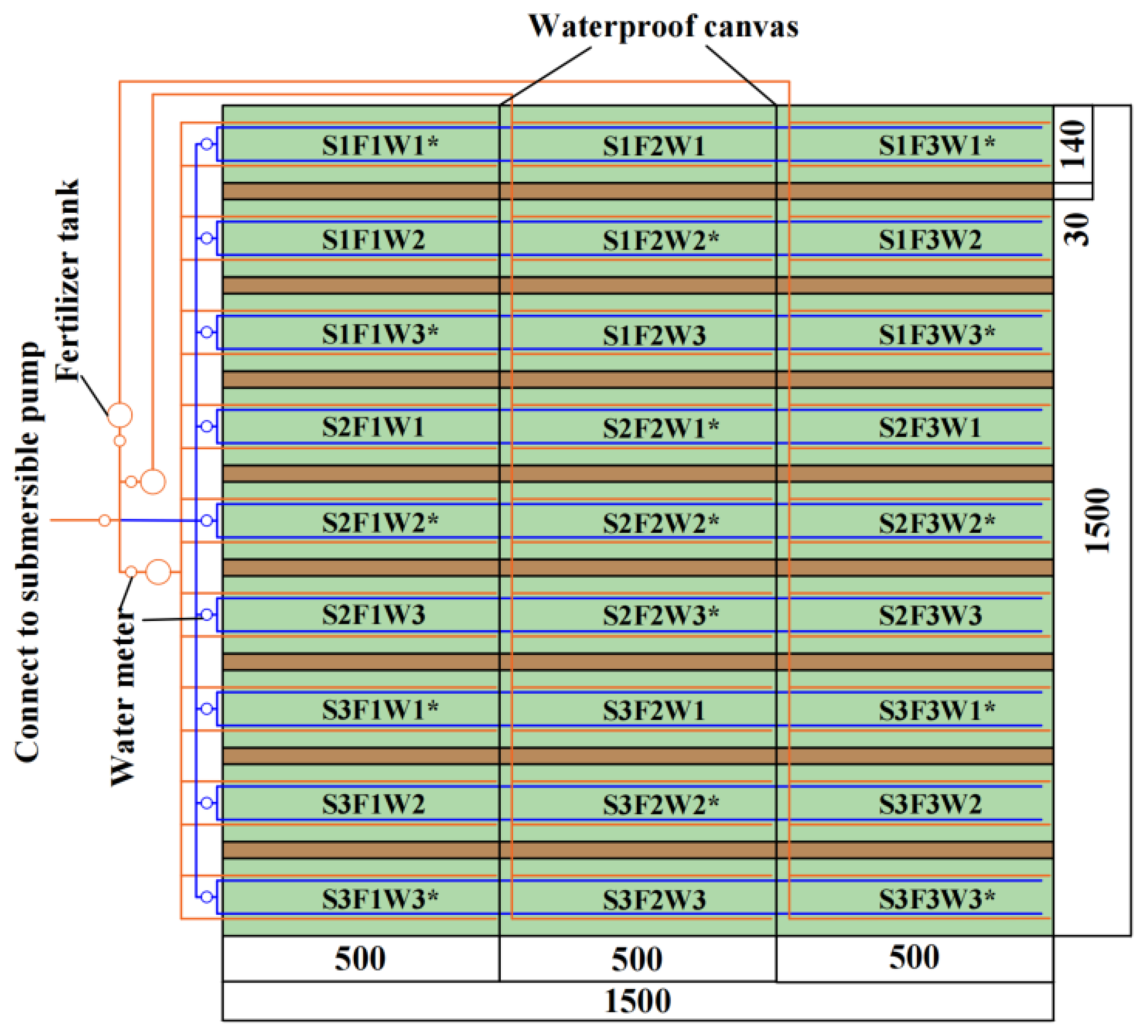
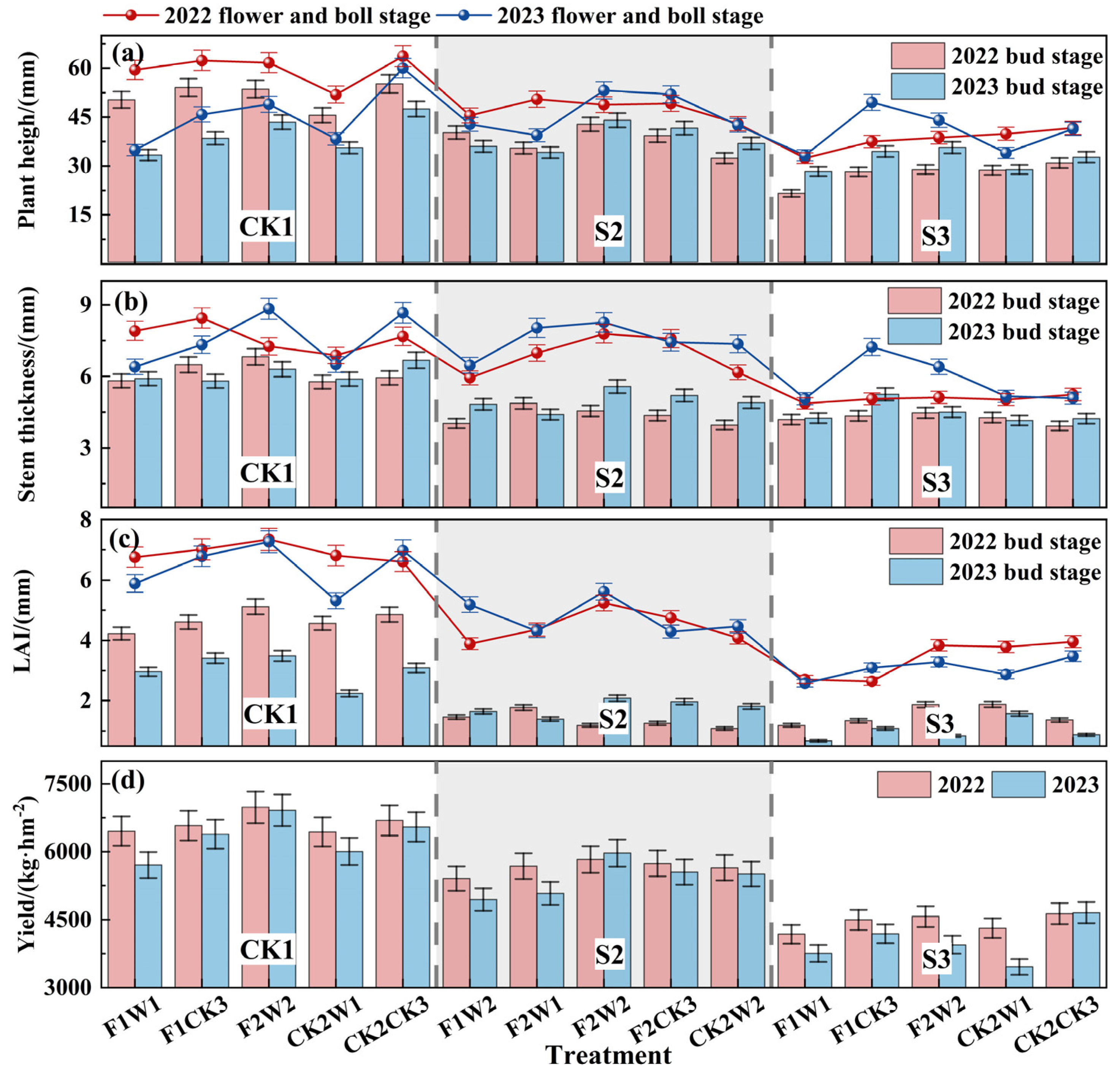

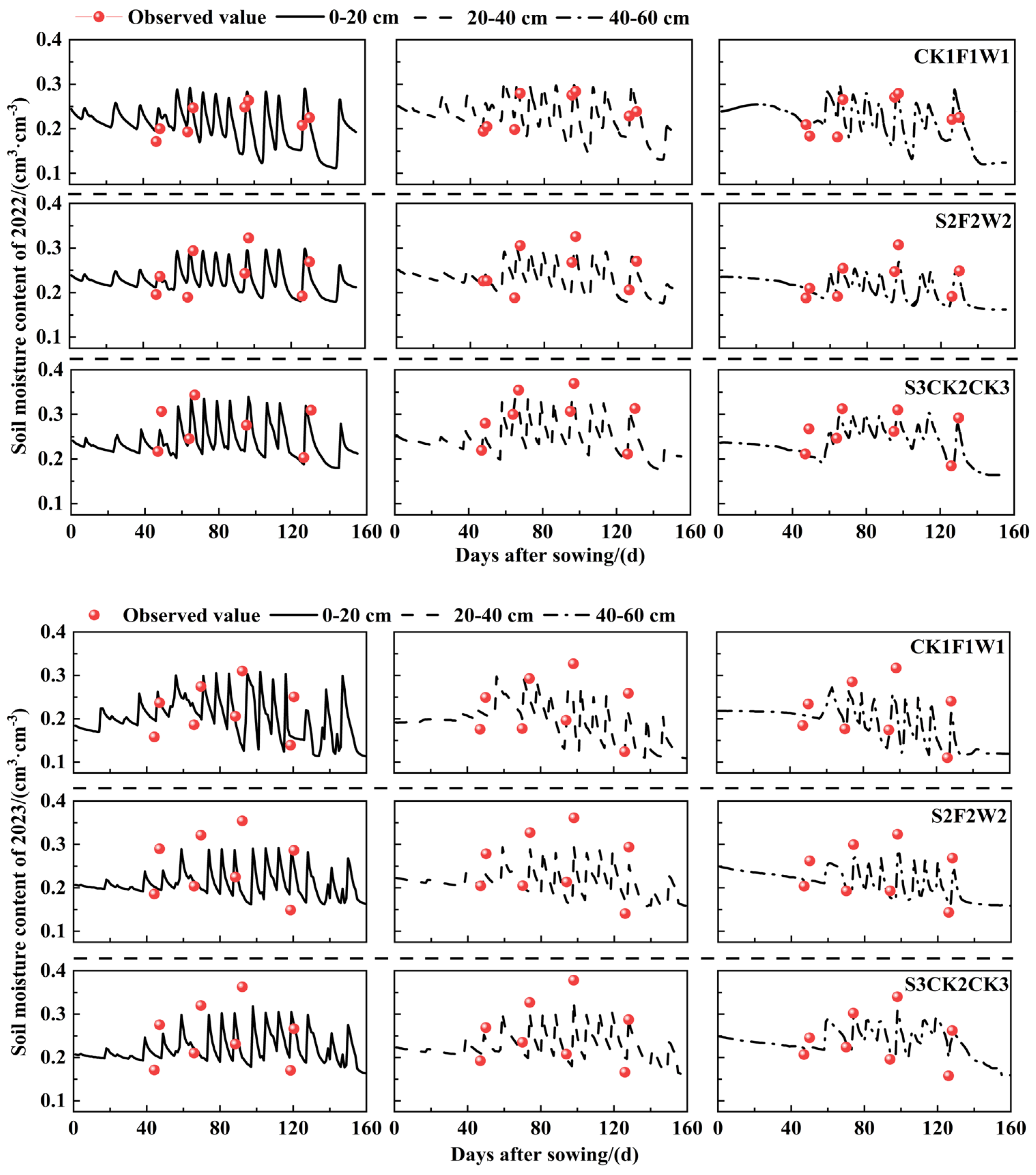
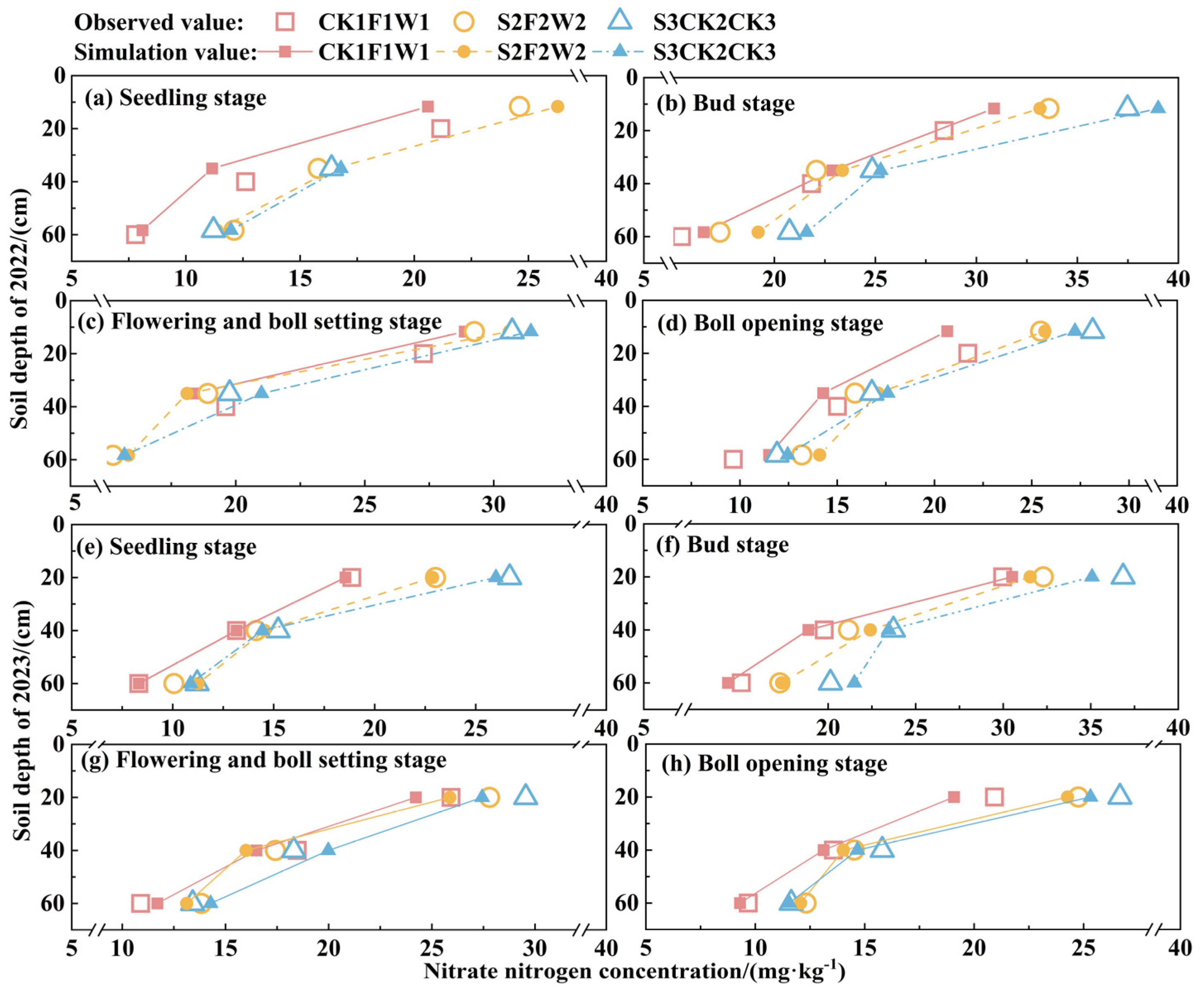
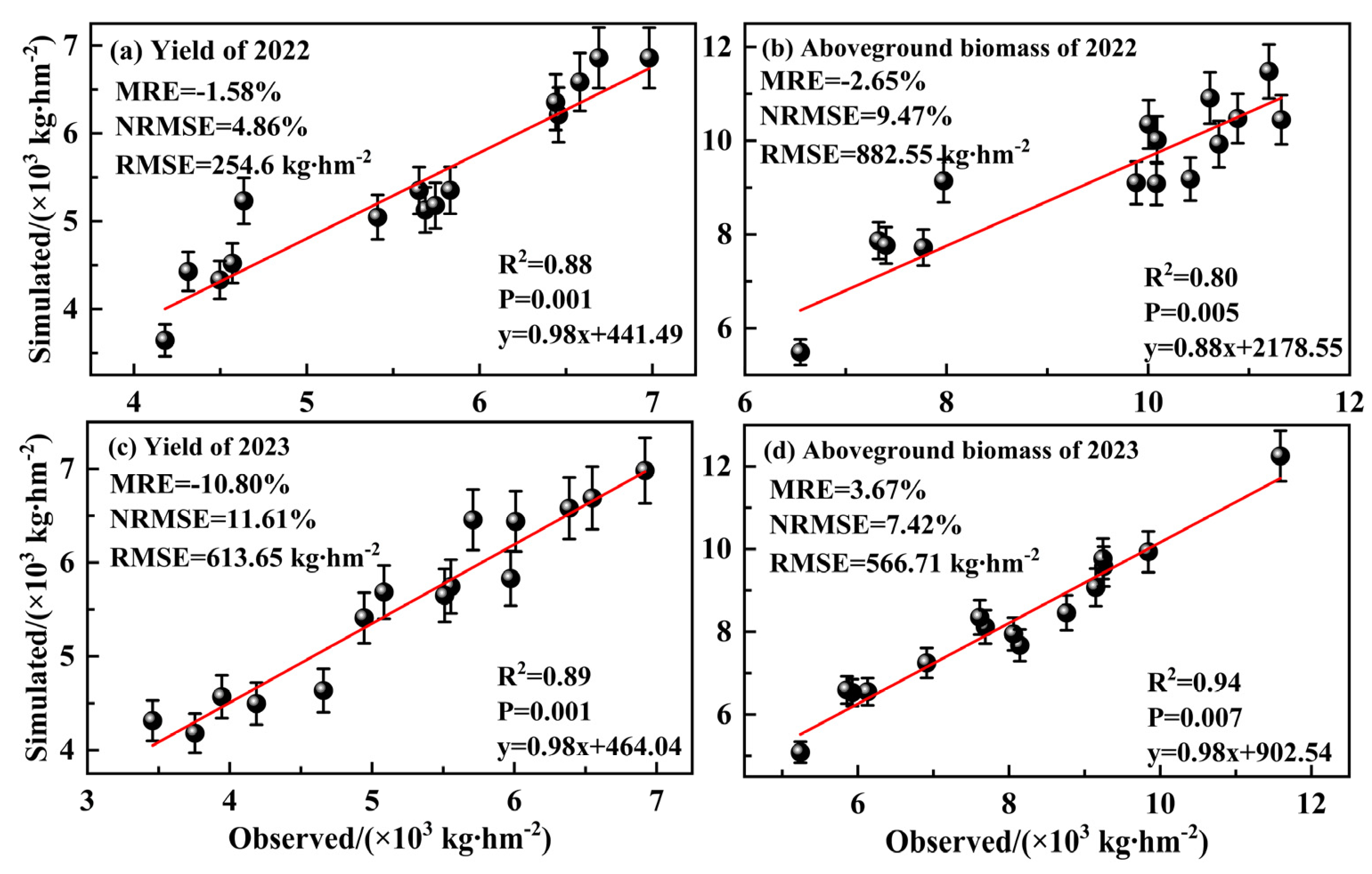
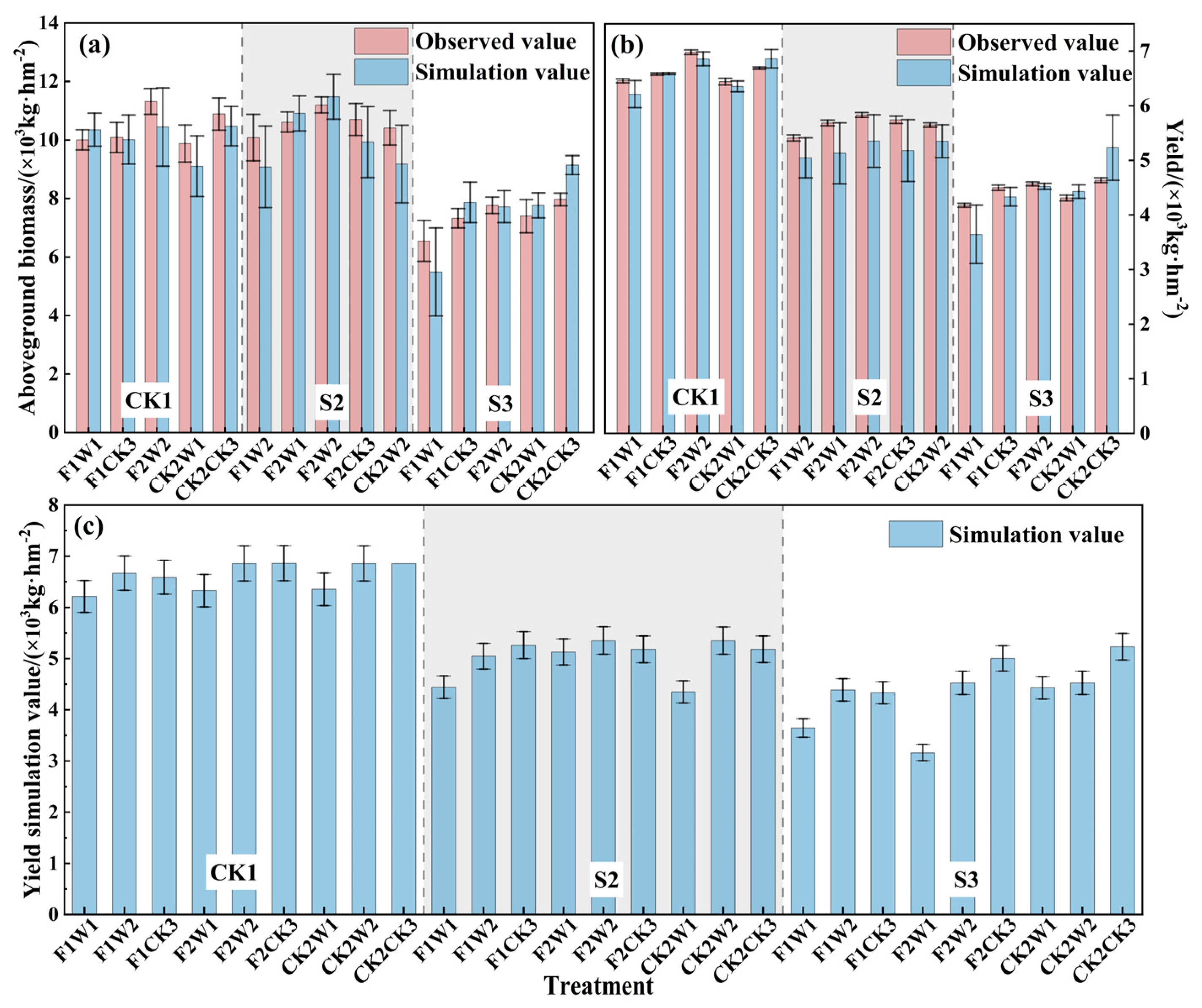
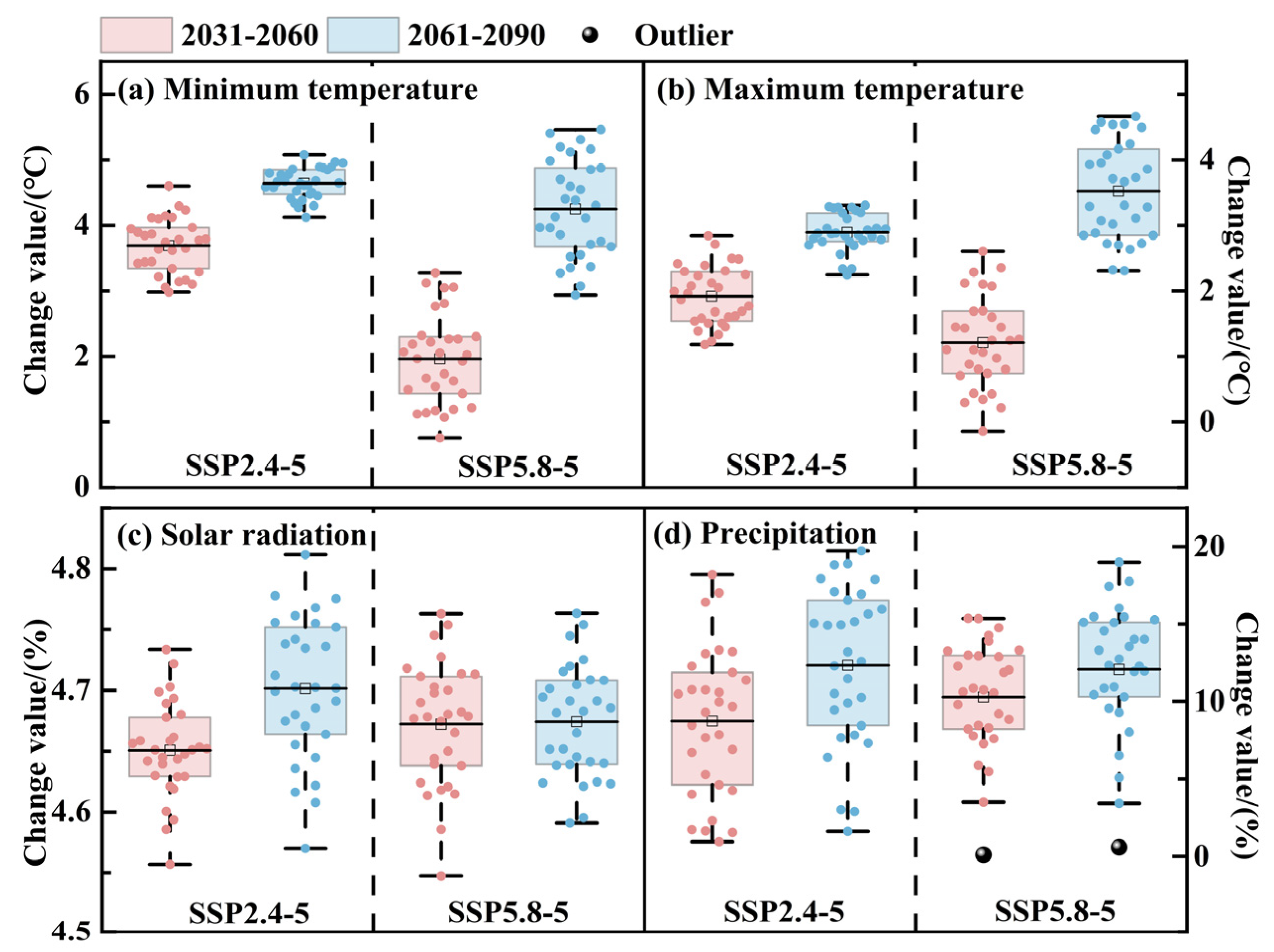
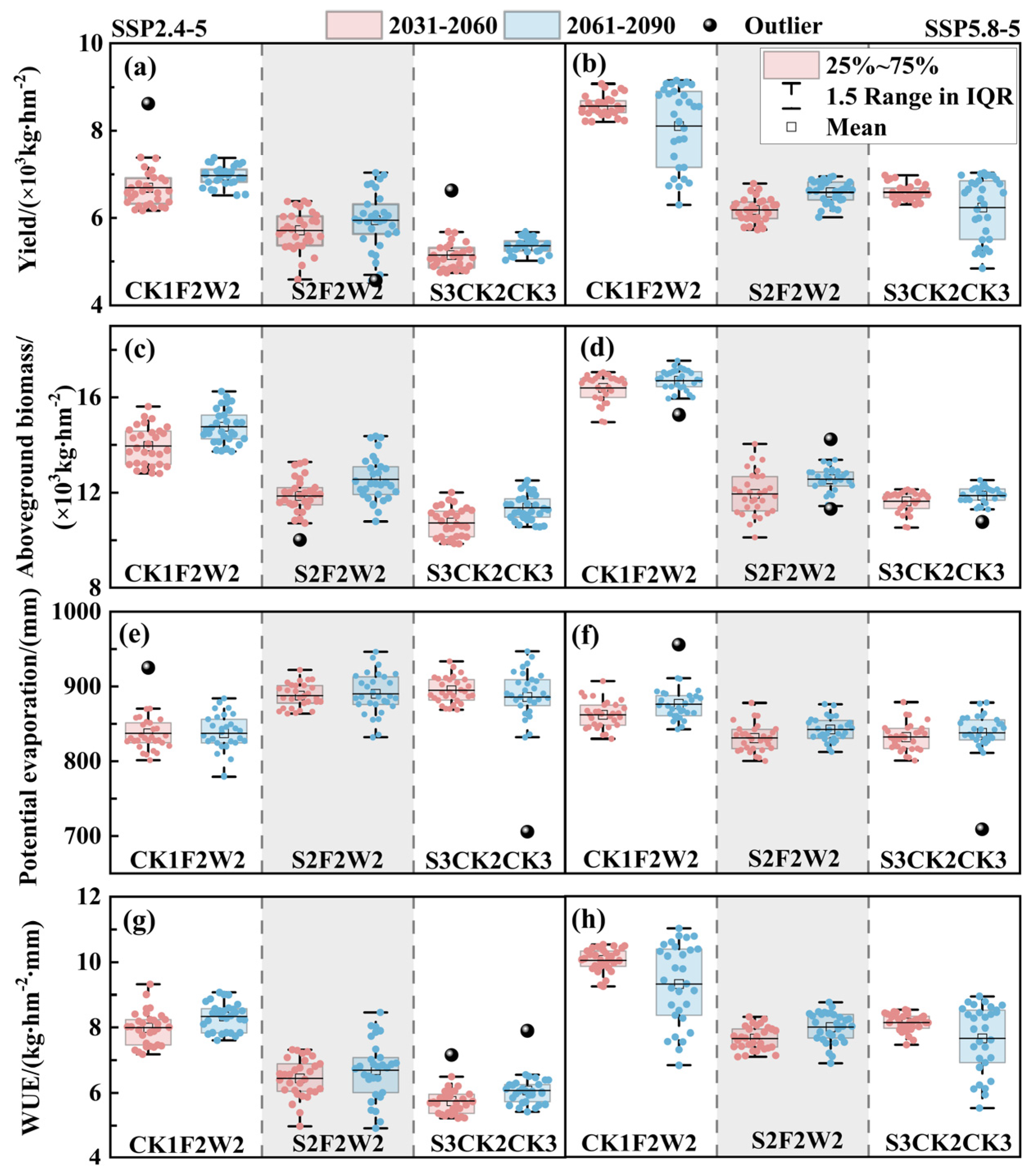
| Growth Period | Irrigation Time/ (Month-Day) | Irrigation Amount/(m3/hm2) | Nitrogen Amount/(kg/hm2) | Phosphate and Potash Fertilizer/(kg/hm2) | |||||
|---|---|---|---|---|---|---|---|---|---|
| 2022 | 2023 | W1 | W2 | CK3 | F1 | F2 | CK2 | ||
| Seedling stage | 15 June | 05 June | 108.0 | 144.0 | 180.0 | 6.6 | 13.1 | 19.7 | 6.8 |
| 25 June | 15 June | ||||||||
| Bud stage | 05 July | 25 June | 297.0 | 396.0 | 495.0 | 13.1 | 26.3 | 39.4 | 13.6 |
| 12 July | 10 July | ||||||||
| 19 July | 17 July | ||||||||
| Flower and boll stage | 26 July | 24 July | 275.4 | 367.2 | 459.0 | 10.5 | 21.0 | 31.5 | 16.3 |
| 02 August | 03 August | ||||||||
| 12 August | 10 August | ||||||||
| 22 August | 17 August | ||||||||
| 29 August | 24 August | ||||||||
| Batting stage | 12 September | 02 September | 216.0 | 288.0 | 360.0 | 0 | 0 | 0 | 0 |
| Parameter | Name | Value | |
|---|---|---|---|
| Before Calibration | After Calibration | ||
| EM-FL | The time between germination and flowering of crops/d | 30~50 | 32 |
| FL-SH | The time from first flower to first pod/d | 8~12 | 8 |
| FL-SD | The time from first flower to first bell/d | 12~20 | 12 |
| SD-PM | The time from the first boll to the ripening of cotton/d | 40~60 | 47 |
| FL-LF | The time from first flower to full leaf development/d | 52~75 | 75 |
| LFMAX | Maximum leaf photosynthetic rate at 30 °C, 350 mg∙kg−1 CO2, and maximum light intensity/(mg⸱m−2/s) | 0.95~1.15 | 1.15 |
| SLAVR | Specific leaf area of crops under normal growing conditions/(cm2/g) | 170~250 | 179 |
| SIZLF | The maximum size of the whole leaf/cm2 | 250~300 | 280 |
| XFRT | The maximum size of the whole leaf | 0.5~1.0 | 0.92 |
| WTPSD | Maximum mass per seed/g | 0.18 | 0.18 |
| SFDUR | Grout duration of pods under normal growth conditions/d | 20~40 | 35 |
| SDPDV | The average number of seeds per pod under normal growing conditions | 20~30 | 27 |
| PODUR | The average number of seeds per pod under normal growing conditions/d | 8~15 | 8 |
| Soil Depth/cm | Hydraulic Conductivity/(g/cm3) | Field Capacity/ (cm3/cm3) | Wilting Point/(cm3/cm3) |
|---|---|---|---|
| 0~20 | 0.4240 | 0.2165 | 0.1095 |
| >20~40 | 0.2300 | 0.1970 | 0.0917 |
| >40~60 | 0.4300 | 0.2335 | 0.1163 |
| Climate Variable | Mean | Climate Tendency Rate (10 y)−1 |
|---|---|---|
| Maximum temperature of growing season (°C) | 26.09 | 0.32 |
| Minimum temperature of growing season (°C) | 11.19 | 0.44 |
| Solar radiation of growing season (MJ/m2/day) | 9.65 | 0.04 |
| Precipitation of growing season (mm) | 136.76 | 3.72 |
| Wind speed of growing season (km/day) | 146.40 | −1.66 |
| Relative humidity of growing season (%) | 52.89 | −0.26 |
Disclaimer/Publisher’s Note: The statements, opinions and data contained in all publications are solely those of the individual author(s) and contributor(s) and not of MDPI and/or the editor(s). MDPI and/or the editor(s) disclaim responsibility for any injury to people or property resulting from any ideas, methods, instructions or products referred to in the content. |
© 2025 by the authors. Licensee MDPI, Basel, Switzerland. This article is an open access article distributed under the terms and conditions of the Creative Commons Attribution (CC BY) license (https://creativecommons.org/licenses/by/4.0/).
Share and Cite
Zhang, F.; Zhang, Z.; Heng, T.; He, X. Optimizing Cotton Irrigation Strategies in Arid Regions Under Water–Salt–Nitrogen Interactions and Projected Climate Impacts. Agronomy 2025, 15, 1305. https://doi.org/10.3390/agronomy15061305
Zhang F, Zhang Z, Heng T, He X. Optimizing Cotton Irrigation Strategies in Arid Regions Under Water–Salt–Nitrogen Interactions and Projected Climate Impacts. Agronomy. 2025; 15(6):1305. https://doi.org/10.3390/agronomy15061305
Chicago/Turabian StyleZhang, Fuchu, Ziqi Zhang, Tong Heng, and Xinlin He. 2025. "Optimizing Cotton Irrigation Strategies in Arid Regions Under Water–Salt–Nitrogen Interactions and Projected Climate Impacts" Agronomy 15, no. 6: 1305. https://doi.org/10.3390/agronomy15061305
APA StyleZhang, F., Zhang, Z., Heng, T., & He, X. (2025). Optimizing Cotton Irrigation Strategies in Arid Regions Under Water–Salt–Nitrogen Interactions and Projected Climate Impacts. Agronomy, 15(6), 1305. https://doi.org/10.3390/agronomy15061305






